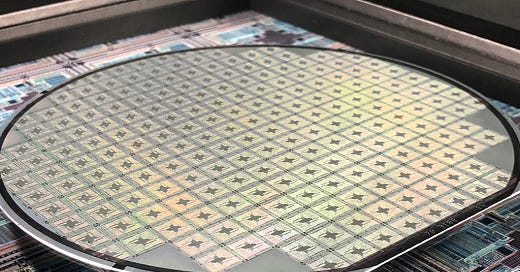Photonic Dawn in China, Electronic Twilight in America.
China scales lithium niobate photonics, slashes cost, leads the post-silicon era in telecom, AI, quantum tech.
In Photonic Dawn last year’s post on this subject, we explored China’s efforts to fabricate photonic integrated circuits, ICs. Today it alone produces six-inch, thin-film lithium niobate photonic chip wafers, in affordable, commercial quantities. Best of all, they’re made in regular IC fabs, cost fifty-percent less and have 100% Chinese IP, thanks to researchers at Shanghai Jiao Tong University, SJTU.
Firsts
SJTU’s wafers are the first 6-inchers and yield 2.25x more chips per wafer compared to 4-inch wafers and cut unit costs 50%.
Compatible with conventional CMOS fabs like SMIC’s and TSMC’s, enabling mass production—a game-changer for scalability.
Solved the Lithium Niobate Paradox. While LN’s electro-optic properties are 100x better than silicon’s, its crystals are brittle and small wafers made LN photonics prohibitively expensive.
Combine LN’s performance with silicon’s manufacturability, cutting chip costs by 50%. Data centers, telecom and quantum computing benefit greatly, while ultra-low loss photonic qubit interconnects are a key hurdle for scalable quantum systems.
Geopolitical significance
China’s control of 6-inch TFLN production could let it dictate future photonic standards, as it did with 5G. The US dominates indium phosphide photonics but Huawei, ZTE, SMEE, and CETC can now integrate TFLN into their photonic systems, circumventing US sanctions.
SJTU’s 6-inch TFLN wafers are a technical milestone and the foundation of a new photonic ecosystem, with ripple effects across telecom, AI, and quantum tech. Watch for SMIC/Huawei to commercialize TFLN chips this year.
Background (from the original post)
In addition to greatly speeding computation, integrated photonics enables lab-on-a-chip (LOC) technology, putting laboratories into doctors’ hands. Amazec Photonics’ fiber optic sensor with photonic chips allow doctors to measure both cardiac output and circulating blood volume from outside the body. PICs facilitate communication between vehicles and urban infrastructure to improve driver safety, and can detect different quantities, such as pressure, temperature, vibrations, accelerations, and mechanical strain. PhotonFirst PICs measure shape changes in airplanes, EV battery temperature, and infrastructure strain. PICs can measure variables beyond the range of the human eye, allowing the food supply chain to detect disease, ripeness and nutrients in fruit and plants. It can also help food producers to determine soil quality and plant growth, and measure CO2 emissions. MantiSpectra’s analyzer fits into a smartphone and can analyze chemical constituents of products like milk and plastics.
Chinese researchers are confident that they have solved the packaging cost problem and will open the first mass production line for "multi-material and cross-size" photonic chips this year, currently being built by Beijing-based Sintone.
Implications
The fab gives China first-mover advantage in a 21st century industry and, probably, as many decades of PIC dominance as America had with ICs. IC demand will continue rising, but China’s photonic success alters the balance of power in the world, while removing Taiwan as a bone of contention. Win-win-win. For China, anyway.
Reading
Columbia Prof. Karen Bergman: Why, How and When of a Technology that Could Transform HPC.
"Efficient photonic chip fabrication with 2.5D printing" by L. Zhang et al. (Nature Communications, June 5, 2021)
"Superior photonic chip fabrication using 2D material-coated microring resonators" by M. Li et al. (Light: Science & Applications, May 15, 2021)
"High-throughput photonic chip fabrication using femtosecond laser processing" by Y. Cheng et al. (Applied Physics Letters, April 15, 2021)






So photonics will be the equivalent of electric engines for cars, both make the Western intellectual property and manufacturing capabilities irrelevant, allowing the Chinese to leapfrog. Goodbye to much of the Western semiconductor industry as well as the automobile industry. This will bring us to very dangerous times, as the Western elites will be very desperate after their last trump card (IP and control of global value chains) is shown to be a dud.
I remember seeing that the US initiated chip ban would set Chinese computing back literally one year. Looks like it might even be less than that lol